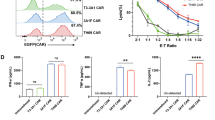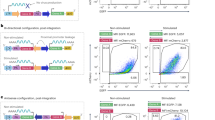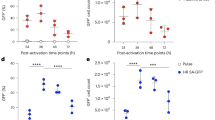Abstract
Adoptive transfer of T lymphocytes is an attractive strategy for many experimental treatment strategies for cancer. Unfortunately, manipulated T cells could be responsible for serious adverse events. Retroviral CD20-transduced T cells may be able to control these unwanted effects. CD20-positive cells are sensitive to rituximab (RTX), a monoclonal antibody specific for CD20. This permits their selective elimination in vivo in case of adverse events. To this end, a system is required that permits efficient and safe transduction of donor T cells and effective elimination of CD20-positive T cells. We constructed different CD20-encoding retroviral vectors and investigated the impact of inclusion of the woodchuck post-transcriptional regulatory element (WPRE) and the chicken hypersensitivity site 4 insulator elements on the levels, homogeneity and stability of CD20 expression. Importantly, inclusion of either WPRE or insulator elements in the retroviral vector resulted in a dramatic improvement in the stability of CD20 expression. The insulator element also led to a much more homogeneous level of CD20 expression. We also show the efficient elimination of the CD20-transgenic T cells via RTX by different effector mechanisms. In conclusion, we have constructed CD20-encoding retroviral vectors with improved efficiency and safety profiles, which can be used as a suicide strategy.
This is a preview of subscription content, access via your institution
Access options
Subscribe to this journal
Receive 12 print issues and online access
$259.00 per year
only $21.58 per issue
Buy this article
- Purchase on Springer Link
- Instant access to full article PDF
Prices may be subject to local taxes which are calculated during checkout







Similar content being viewed by others
References
Bonini C, Ferrari G, Verzeletti S, Servida P, Zappone E, Ruggieri L et al. HSV-TK gene transfer into donor lymphocytes for control of allogeneic graft-versus-leukemia. Science 1997; 276: 1719–1724.
Tiberghien P, Reynolds CW, Keller J, Spence S, Deschaseaux M, Certoux JM et al. Ganciclovir treatment of herpes simplex thymidine kinase-transduced primary T lymphocytes: an approach for specific in vivo donor T-cell depletion after bone marrow transplantation? Blood 1994; 84: 1333–1341.
Introna M, Barbui AM, Bambacioni F, Casati C, Gaipa G, Borleri G et al. Genetic modification of human T cells with CD20: a strategy to purify and lyse transduced cells with anti-CD20 antibodies. Hum Gene Ther 2000; 11: 611–620.
Serafini M, Manganini M, Borleri G, Bonamino M, Imberti L, Biondi A et al. Characterization of CD20-transduced T lymphocytes as an alternative suicide gene therapy approach for the treatment of graft-versus-host disease. Hum Gene Ther 2004; 15: 63–76.
Cartron G, Watier H, Golay J, Solal-Celigny P . From the bench to the bedside: ways to improve rituximab efficacy. Blood 2004; 104: 2635–2642.
Flieger D, Renoth S, Beier I, Sauerbruch T, Schmidt-Wolf I . Mechanism of cytotoxicity induced by chimeric mouse human monoclonal antibody IDEC-C2B8 in CD20-expressing lymphoma cell lines. Cell Immunol 2000; 204: 55–63.
Johnson P, Glennie M . The mechanisms of action of rituximab in the elimination of tumor cells. Semin Oncol 2003; 30: 3–8.
Smith MR . Rituximab (monoclonal anti-CD20 antibody): mechanisms of action and resistance. Oncogene 2003; 22: 7359–7368.
Frank O, Rudolph C, Heberlein C, von NN, Schrock E, Schambach A et al. Tumor cells escape suicide gene therapy by genetic and epigenetic instability. Blood 2004; 104: 3543–3549.
Hacein-Bey-Abina S, von KC, Schmidt M, McCormack MP, Wulffraat N, Leboulch P et al. LMO2-associated clonal T cell proliferation in two patients after gene therapy for SCID-X1. Science 2003; 302: 415–419.
Golay J, Lazzari M, Facchinetti V, Bernasconi S, Borleri G, Barbui T et al. CD20 levels determine the in vitro susceptibility to rituximab and complement of B-cell chronic lymphocytic leukemia: further regulation by CD55 and CD59. Blood 2001; 98: 3383–3389.
Donello JE, Loeb JE, Hope TJ . Woodchuck hepatitis virus contains a tripartite posttranscriptional regulatory element. J Virol 1998; 72: 5085–5092.
Johansen J, Tornoe J, Moller A, Johansen TE . Increased in vitro and in vivo transgene expression levels mediated through cis-acting elements. J Gene Med 2003; 5: 1080–1089.
Zufferey R, Donello JE, Trono D, Hope TJ . Woodchuck hepatitis virus posttranscriptional regulatory element enhances expression of transgenes delivered by retroviral vectors. J Virol 1999; 73: 2886–2892.
Emery DW, Yannaki E, Tubb J, Stamatoyannopoulos G . A chromatin insulator protects retrovirus vectors from chromosomal position effects. Proc Natl Acad Sci USA 2000; 97: 9150–9155.
Emery DW, Yannaki E, Tubb J, Nishino T, Li Q, Stamatoyannopoulos G . Development of virus vectors for gene therapy of beta chain hemoglobinopathies: flanking with a chromatin insulator reduces gamma-globin gene silencing in vivo. Blood 2002; 100: 2012–2019.
Rivella S, Callegari JA, May C, Tan CW, Sadelain M . The cHS4 insulator increases the probability of retroviral expression at random chromosomal integration sites. J Virol 2000; 74: 4679–4687.
Kozak M . The scanning model for translation: an update. J Cell Biol 1989; 108: 229–241.
Ramezani A, Hawley TS, Hawley RG . Performance- and safety-enhanced lentiviral vectors containing the human interferon-beta scaffold attachment region and the chicken beta-globin insulator. Blood 2003; 101: 4717–4724.
Yannaki E, Tubb J, Aker M, Stamatoyannopoulos G, Emery DW . Topological constraints governing the use of the chicken HS4 chromatin insulator in oncoretrovirus vectors. Mol Ther 2002; 5: 589–598.
Kustikova OS, Wahlers A, Kuhlcke K, Stahle B, Zander AR, Baum C et al. Dose finding with retroviral vectors: correlation of retroviral vector copy numbers in single cells with gene transfer efficiency in a cell population. Blood 2003; 102: 3934–3937.
Li Z, Dullmann J, Schiedlmeier B, Schmidt M, von KC, Meyer J et al. Murine leukemia induced by retroviral gene marking. Science 2002; 296: 497.
Cartron G, Dacheux L, Salles G, Solal-Celigny P, Bardos P, Colombat P et al. Therapeutic activity of humanized anti-CD20 monoclonal antibody and polymorphism in IgG Fc receptor FcgammaRIIIa gene. Blood 2002; 99: 754–758.
Clynes RA, Towers TL, Presta LG, Ravetch JV . Inhibitory Fc receptors modulate in vivo cytoxicity against tumor targets. Nat Med 2000; 6: 443–446.
Pfeiffer M, Stanojevic S, Feuchtinger T, Greil J, Handgretinger R, Barbin K et al. Rituximab mediates in vitro antileukemic activity in pediatric patients after allogeneic transplantation. Bone Marrow Transplant 2005; 36: 91–97.
Kingsman SM, Mitrophanous K, Olsen JC . Potential oncogene activity of the woodchuck hepatitis post-transcriptional regulatory element (WPRE). Gene Therapy 2005; 12: 3–4.
Sirma H, Giannini C, Poussin K, Paterlini P, Kremsdorf D, Brechot C . Hepatitis B virus X mutants, present in hepatocellular carcinoma tissue abrogate both the antiproliferative and transactivation effects of HBx. Oncogene 1999; 18: 4848–4859.
Poussin K, Dienes H, Sirma H, Urban S, Beaugrand M, Franco D et al. Expression of mutated hepatitis B virus X genes in human hepatocellular carcinomas. Int J Cancer 1999; 80: 497–505.
Engels B, Cam H, Schuler T, Indraccolo S, Gladow M, Baum C et al. Retroviral vectors for high-level transgene expression in T lymphocytes. Hum Gene Ther 2003; 14: 1155–1168.
Serafini M, Bonamino M, Golay J, Introna M . Elongation factor 1 (EF1alpha) promoter in a lentiviral backbone improves expression of the CD20 suicide gene in primary T lymphocytes allowing efficient rituximab-mediated lysis. Haematologica 2004; 89: 86–95.
Kohn DB, Sadelain M, Glorioso JC . Occurrence of leukaemia following gene therapy of X-linked SCID. Nat Rev Cancer 2003; 3: 477–488.
Baum C, von KC, Staal FJ, Li Z, Fehse B, Schmidt M et al. Chance or necessity? Insertional mutagenesis in gene therapy and its consequences. Mol Ther 2004; 9: 5–13.
Kohn DB, Sadelain M, Dunbar C, Bodine D, Kiem HP, Candotti F et al. American Society of Gene Therapy (ASGT) ad hoc subcommittee on retroviral-mediated gene transfer to hematopoietic stem cells. Mol Ther 2003; 8: 180–187.
Walters MC, Fiering S, Bouhassira EE, Scalzo D, Goeke S, Magis W et al. The chicken beta-globin 5′HS4 boundary element blocks enhancer-mediated suppression of silencing. Mol Cell Biol 1999; 19: 3714–3726.
Schambach A, Wodrich H, Hildinger M, Bohne J, Krausslich HG, Baum C . Context dependence of different modules for posttranscriptional enhancement of gene expression from retroviral vectors. Mol Ther 2000; 2: 435–445.
Auten J, Agarwal M, Chen J, Sutton R, Plavec I . Effect of scaffold attachment region on transgene expression in retrovirus vector-transduced primary T cells and macrophages. Hum Gene Ther 1999; 10: 1389–1399.
Kessels HW, van dB, Spits H, Hooijberg E, Schumacher TN . Changing T cell specificity by retroviral T cell receptor display. Proc Natl Acad Sci USA 2000; 97: 14578–14583.
Weijtens M, van SA, Hagenbeek A, Braakman E, Martens A . Reduced graft-versus-host disease-inducing capacity of T cells after activation, culturing, and magnetic cell sorting selection in an allogeneic bone marrow transplantation model in rats. Hum Gene Ther 2002; 13: 187–198.
Jedema I, van der Werff NM, Barge RM, Willemze R, Falkenburg JH . New CFSE-based assay to determine susceptibility to lysis by cytotoxic T cells of leukemic precursor cells within a heterogeneous target cell population. Blood 2004; 103: 2677–2682.
Acknowledgements
We are grateful to Dr Ton NM Schumacher (Netherlands Cancer Institute, Amsterdam, The Netherlands) for providing the pMX retroviral vector; Dr Gary Nolan (Stanford University, Stanford, CA) for the amphotrophic packaging cell line Phoenix; Dr Christopher Baum for the WPRE element and Dr Gary Felsenfeld for insulator elements. The work was supported by EC Grant QLK3 CT 2001-01265.
Author information
Authors and Affiliations
Corresponding author
Rights and permissions
About this article
Cite this article
van Meerten, T., Claessen, MJ., Hagenbeek, A. et al. The CD20/αCD20 ‘suicide’ system: novel vectors with improved safety and expression profiles and efficient elimination of CD20-transgenic T cells. Gene Ther 13, 789–797 (2006). https://doi.org/10.1038/sj.gt.3302705
Received:
Revised:
Accepted:
Published:
Issue Date:
DOI: https://doi.org/10.1038/sj.gt.3302705
Keywords
This article is cited by
-
Antitumor effects of an engineered and energized fusion protein consisting of an anti-CD20 scFv fragment and lidamycin
Science China Life Sciences (2011)
-
An Improved Bicistronic CD20/tCD34 Vector for Efficient Purification and In Vivo Depletion of Gene-Modified T Cells for Adoptive Immunotherapy
Molecular Therapy (2010)
-
Adoptive T-cell Immunotherapy of Cancer Using Chimeric Antigen Receptor-Grafted T Cells
Archivum Immunologiae et Therapiae Experimentalis (2010)
-
TCR transgenes and transgene cassettes for TCR gene therapy: status in 2008
Cancer Immunology, Immunotherapy (2009)
-
Sleeping Beauty Transposon‐mediated Engineering of Human Primary T Cells for Therapy of CD19+ Lymphoid Malignancies
Molecular Therapy (2008)



